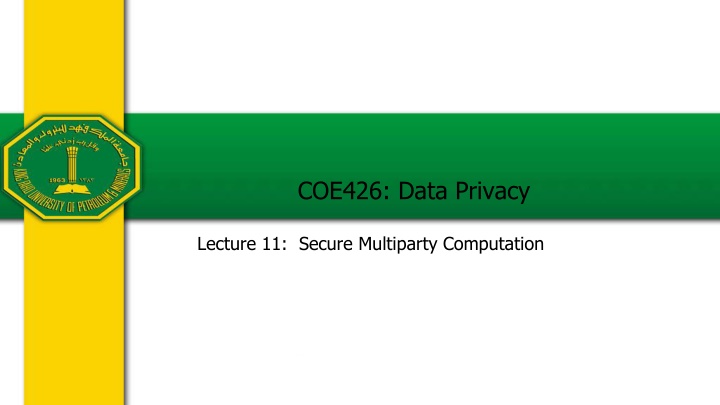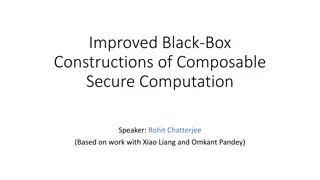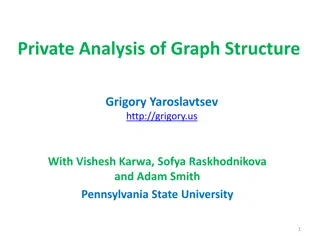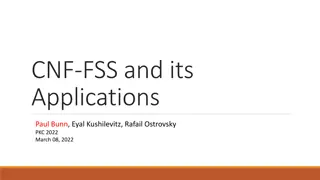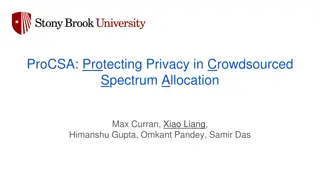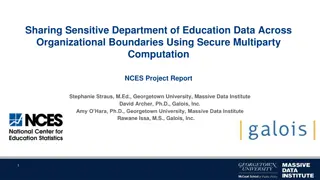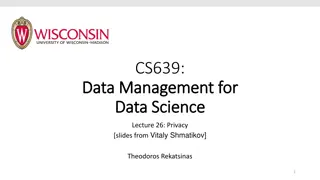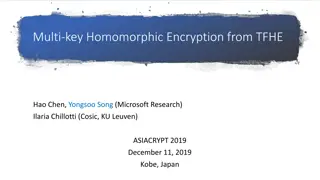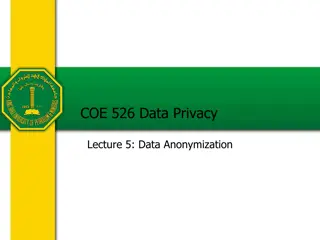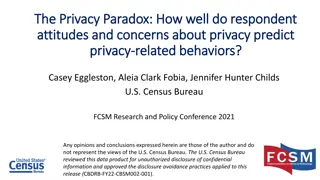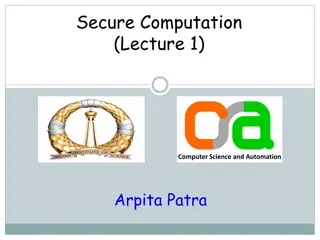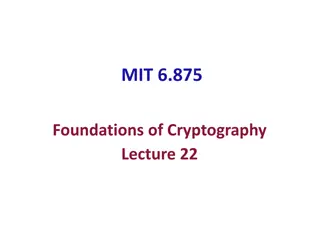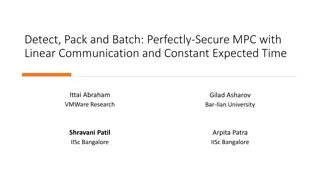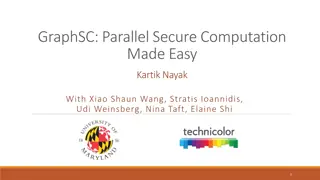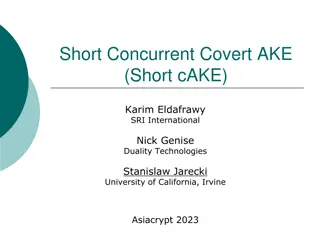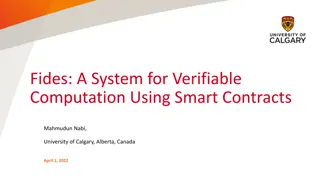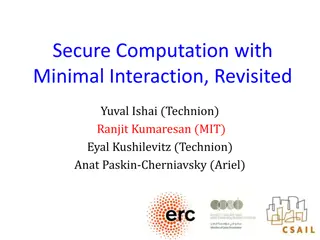Secure Multiparty Computation: Enhancing Privacy in Data Sharing
Secure multiparty computation (SMC) enables parties with private inputs to compute joint functions without revealing individual data, ensuring privacy and correctness. This involves computations on encrypted data using techniques like homomorphic encryption for scenarios like e-voting. SMC serves as a general framework for secure computations among untrusting parties, preserving security against adversarial behavior. Examples include elections, auctions, distributed data mining, and database privacy, showcasing the importance of protecting sensitive information while collaborating.
Download Presentation

Please find below an Image/Link to download the presentation.
The content on the website is provided AS IS for your information and personal use only. It may not be sold, licensed, or shared on other websites without obtaining consent from the author.If you encounter any issues during the download, it is possible that the publisher has removed the file from their server.
You are allowed to download the files provided on this website for personal or commercial use, subject to the condition that they are used lawfully. All files are the property of their respective owners.
The content on the website is provided AS IS for your information and personal use only. It may not be sold, licensed, or shared on other websites without obtaining consent from the author.
E N D
Presentation Transcript
COE426: Data Privacy Lecture 11: Secure Multiparty Computation
Computing on Encrypted Data Basic idea Client encrypts his data ? and sends encryption ?(?) to the server The server performs some computation (evaluate function ?) and returns the encrypted result to the client The client decrypts the result to find out the answer, but the server learns nothing about the data Homomorphic encryption 2 COE426: Lecture 11
E-Voting Example using Homeomorphic Encryption We have three candidates: Don, Joe, and West We want to construct a "fast" and secure voting system We can assign certain number of bits for each candidate Don: 010000, Joe: 000100, West: 000001 Assume we have 6 people voting and results are as follows Voter 1 2 3 4 5 6 Don Joe West X Bit Score 00 00 01=1 00 01 00=4 00 01 00=4 00 00 01=1 01 00 00=16 00 00 01=1 COE426: Lecture 11 X X X X X 3
E-Voting Example using Homeomorphic Encryption Votes need to be added -> use Paillier Cryptosystem Use p =5, q=7, n = 35, n2=1225, ? = 12,g = 141 X r Enc(x, r) 359 173 486 1088 541 163=983 mod 1225 ??? 983 ??? 1225 = 27 27 = 01 10 11 1 4 4 1 4 359 173 486 1088 541 163 17 26 12 11 32 Don received 1 vote (01) Joe received 2 votes (10) West received 3 votes (11) 16 1 4 COE426: Lecture 11
Secure Multiparty Computation (SMC) General framework for describing computation between parties who do not trust each other A set of parties with private inputs wish to compute some joint function of their inputs Parties wish to preserve some security properties. e.g., privacy and correctness Security must be preserved in the face of adversarial behavior by some of the participants, or an external party 5 COE426: Lecture 11
SMC Examples Elections N parties, each one has a Yes or No vote Goal: determine whether the majority voted Yes , but no voter should learn how other people voted Auctions Each bidder makes an offer Offer should be committing! (can t change it later) Goal: determine whose offer won without revealing losing offers Distributed data mining Two companies want to compare their datasets without revealing them For example, compute the intersection of two lists of names Database privacy Evaluate a query on the database without revealing the query to the database owner Evaluate a statistical query on the database without revealing the values of individual entries Many variations 6 COE426: Lecture 11
A Couple of Observations In all cases, we are dealing with distributed multi-party protocols A protocol describes how parties are supposed to exchange messages on the network All of these tasks can be easily computed by a trusted third party The goal of secure multi-party computation is to achieve the same result without involving a trusted third party COE426: Lecture 11 slide 7
Security Requirements Privacy: only the output is revealed Correctness: the function is computed correctly Independence of inputs: parties cannot choose inputs based on others inputs Fairness: if one party receives output, all receive output Guaranteed output delivery 8 COE426: Lecture 11
Security Requirements: Example Consider a secure auction (with secret bids): An adversary may wish to learn the bids of all parties to prevent this, require PRIVACY An adversary may wish to win with a lower bid than the highest to prevent this, require CORRECTNESS The adversary may also wish to ensure that it always gives the highest bid to prevent this, require INDEPENDENCE OF INPUTS An adversary may try to abort the execution if its bid is not the highest require FAIRNESS 9 COE426: Lecture 11
How to Define Security? Must be mathematically rigorous Must capture all realistic attacks that a malicious participant may try to stage Should be "abstract" Based on the desired "functionality" of the protocol, not a specific protocol Goal: define security for an entire class of protocols 10 COE426: Lecture 11 slide20
Heuristic Approach to Security Approach 1 1. Build a protocol 2. Try to break the protocol 3. Fix the break 4. Return to (2) Problems Real adversaries won t tell you that they have broken the protocol You can never be really sure that the protocol is secure Approach 2 1. Design a protocol 2. Provide a list of attacks that (provably) cannot be carried out on the protocol 3. Reason that the list is complete Problem: often, the list of attacks is not complete Zero-day attacks!! 1. 2. 11 COE426: Lecture 11
A Rigorous Approach Provide an exact problem definition Adversarial power Network model Meaning of security Prove that the protocol is secure Often by reduction to an assumed hard problem, like factoring large composites 12 COE426: Lecture 11
SMC Functionality ? mutually distrustful parties want to jointly carry out some task The input to the function is ? (private) input, the output is ? outputs ? can be either a probabilistic or a deterministic map function from inputs to outputs In general, we can model ? as ?: 0,1 ? ( 0,1 )? K inputs (one per party); each input is a bitstring K outputs Assume that ? is computable in polynomial time, for example, ? ?,? = ( ? ? ,(? ?)) 13 COE426: Lecture 11
Defining Security The real/ideal (simulation) model paradigm for defining security Ideal model: parties send inputs to a trusted party, who computes the function for them Real model: parties run a real protocol with no trusted help The security of a protocol can be checked by comparing what an adversary can do in a real protocol execution to what it can do in an ideal scenario (simulation) A protocol is secure if any adversary in the real model can do no more harm than if it was involved in the ideal model In other words, an adversary should have an indistinguishable view of the protocols 14 COE426: Lecture 11
Ideal Model Intuitively, we want the protocol to behave "as if" a trusted third party collected the parties inputs and computed the desired functionality Computation in the ideal model is secure by definition! x2 x1 A B f2(x1,x2) f1(x1,x2) 15 COE426: Lecture 11
More Formally A protocol is secure if it emulates an ideal setting where the parties hand their inputs to a trusted party, who locally computes the desired outputs and hands them back to the parties [Goldreich-Micali-Wigderson 1987] x2 x1 A B f2(x1,x2) f1(x1,x2) 16 COE426: Lecture 11
Real world No trusted third party Participants run some protocol amongst themselves without any help Despite that, secure protocol should emulate an ideal setting. Real protocol that is run by the participants is secure if no adversary can do more harm in real execution than an execution that takes place in the ideal world 17 COE426: Lecture 11
Adversary Models Some participants may be dishonest (corrupt) If all were honest, we would not need secure multi-party computation Semi-honest (aka passive; honest-but-curious) Follows protocol, but tries to learn more from received messages than he would learn in the ideal model Malicious Deviates from the protocol in arbitrary ways, lies about his inputs, may quit at any point For now, focus on semi-honest adversaries and two-party protocols 18 COE426: Lecture 11
Properties of the Definition How do we argue that the real protocol "emulates" the ideal protocol? Correctness All honest participants should receive the correct result of evaluating function ? Because a trusted third party would compute f correctly Privacy All corrupt participants should learn no more from the protocol than what they would learn in ideal model 19 COE426: Lecture 11 slide28
Simulation Corrupt participant s view of the protocol is the record of messages sent and received In the ideal world, view consists simply of his input and the result of evaluating f How to argue that real protocol does not leak more useful information than ideal-world view? Key idea: simulation If real-world view (i.e., messages received in the real protocol) can be simulated with access only to the ideal- world view, then real-world protocol is secure Simulation must be indistinguishable from real view 20 COE426: Lecture 11
Yaos Millionaire Problem I am more rich I am rich Two millionaires, Alice and Bob want to know which of them is richer without revealing their actual wealth This problem is analogous to a more general problem where there are two numbers A and B and the goal is to solve the inequality without revealing the actual values of A and B 21 COE426: Lecture 11
HE-based Solution: Setup Assume Alice has ? = $7 and Bob has ? = $2 We need to represent ? and ? using binary numbers of length n Let ? = ???? 1 ??+1?1, ?? 0,1? X=7=1112, Y=2=0102 We define two types of encoding 0-encoding of ? is a set ?? Invert the least significant bit of all prefixes of ? tailing 0 0 = {}, ?? 1-encoding of ? is a set ?? All prefix of ? tailing 1 1 = {1,11,111}, ?? ? > ? if and only if ?? {1,11,111} {1,011}={1} 0= ???? 1 ??+11 ??= 0 1 ? ? 1. 0= {1,011} ?? X=7=111 has three prefixes 1. 1 2. 11 3. 111 Y=2=010 has three prefixes 1. 0 2. 01 3. 010 1= ???? 1 ??+1????= 1 1 ? ? 2. 1= {01} 1 and ?? ?? 0has a common element, i.e., ?? 1 ?? 0 22 COE426: Lecture 11
HE-based Solution: Protocol Bob (Y=2=010) Alice (X=7=111) Alice sends a matrix ?2 ? to Bob, where ? ??,? = ? 1 ,? ??,? = ? ??,?? is random 1. ?(?2) ?(1) ?(?1) ?(1) ?(?0) ?(1) 2 1 0 0 1 ?(?2) ?(1) ?(?1) ?(1) ?(?0) ?(1) Bob does the following Finds ?? Computes ??= ? ??,? ? ?? 1,? 1 ? ??,? for each ? = ???? 1 ?? ?? Chooses another n |?? forming a new set {?1,?2, ,??} and sends them back to Alice after random permutation 2. 0= {1,011} ?? ?{1}= ?[1,0]= ? 1 ?{011}= ? 0,2 ? 0,1 ?[1,0] = ? ?2? ?1? 1 {? ?2? ?1? 1 ,? 1 ,?1} 0 A. B. 0 0| random ciphertexts C. {? ?2? ?1? 1 ,? 1 ,?1} Alice decrypts all ??, check whether some of them are 1 which indicates x>y 3. ?(? 1 ) = 1 COE426: Lecture 11 23
Another Example Bob (Y=6=110) Alice (X=7=111) 0 = {??????} ?? 1 = {1,11,111} ?? ?(?2) ?(1) ?(?1) ?(1) ?(?0) ?(1) ?(?2) ?(1) ?(?1) ?(1) ?(?0) ?(1) 0= {111} ?? ?{111}= ? 1,2 ? 1,1 ?[1,0] = ? 1 ? 1 ? 1 {c3,? 1 ? 1 ? 1 ,?2} {c3,? 1 ? 1 ? 1 ,?2} ?(? 1 ? 1 ? 1 ) = ?(? 1.1.1 ) = 1 COE426: Lecture 11 24
Another Example Bob (Y=6=110) Alice (X=5=101) 0 = {??????} ?? 1 = {?????} ?? ?(?2) ?(1) ?(1) ?(?1) ?(?0) ?(1) ?(?2) ?(1) ?(1) ?(?1) ?(?0) ?(1) 0= {111} ?? ?{111}= ? 1,2 ? 1,1 ?[1,0] = ? 1 ? ?1? 1 {c3,? 1 ? ?1? 1 ,?2} {c3,? 1 ? ?1? 1 ,?2} ?(? 1 ? ?1? 1 ) = ?(? 1.?1.1 ) 1 COE426: Lecture 11 25
Private Set Intersection (PSI) The previous protocol is an example of an important application in SMC: Private/secure set intersection PSI has an important application in COVID-19 contact tracing applications EPIONE is a contact tracing application that uses PSI to detect whether a user has contacted a positive person 26 COE426: Lecture 11
Summary Secure multiparty computation is a framework for secure distributed computing If a trusted third-party exists, no need for SMC Security and privacy of SMC can be proven using simulation of real/ideal model Example of SMC: Yao's Millionaire problem Solution to Yao's Millionaire problem using Homeomorphic encryption Next, a solution for general Yao's millionaire problem K parties Any arbitrary function 27 COE426: Lecture 11
